Among the many benefits of cooking foods sous vide and finishing on the grill–flavor, tenderness, convenience, enjoying your own party–one missing ingredient for serious barbecue devotees is the deep smoky flavor in barbecued foods when they visit the grill only for a quick surface sear.
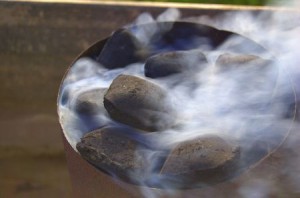 We’re fans of smoky goodness, too, so we were determined to find a way (or ways) that we could impart the complex flavors of smoke to sous vide cooked meats and fish, but not wind up with an overcooked end product. We didn’t want to undermine the whole point of sous vide perfection in these areas in search of smoke.
We’re fans of smoky goodness, too, so we were determined to find a way (or ways) that we could impart the complex flavors of smoke to sous vide cooked meats and fish, but not wind up with an overcooked end product. We didn’t want to undermine the whole point of sous vide perfection in these areas in search of smoke.
So the question was how? Hot or cold? Before or after? Let’s take a look at the possibilities.
Hot Smoking
Hot smoking is a traditional method of slowly cooking food over an indirect fire. Pretty much all great Southern barbecue is slow cooked in hot smoke, typically in the 225F to 250F (107C to 120C) range for varying amounts of time per pound. In the hands of an experienced pit master, it can be sublime and each one has his (or her) own secrets to attain perfection.The meat or fish so handled often reaches internal temperatures of 185F/85C or more, which, in the hands of lesser pit mortals, because they’re well above the rare to medium rare range we might like for, say, a hunk of prime rib or tri-tip roast, could result in an outcome less sublime.
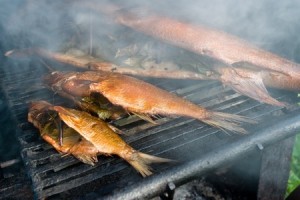 With great care in timing, however, you can impart some smoke with a brief visit to a hot smoker (say maybe 10 to 20 minutes depending on the thickness of what you’re smoking) but this will only give time for the smoke to permeate the very outer parts of the meat surface and might be too long for fish.
With great care in timing, however, you can impart some smoke with a brief visit to a hot smoker (say maybe 10 to 20 minutes depending on the thickness of what you’re smoking) but this will only give time for the smoke to permeate the very outer parts of the meat surface and might be too long for fish.
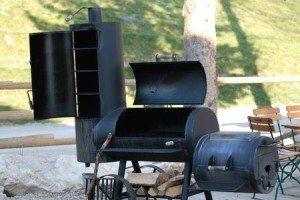 This kind of hot smoking technique is one done in a dedicated hot smoker with an offset firebox, like the set up at right, or even just in a closed-top grill with a pan of wood chips on the flame and the food kept well away from the direct heat. Or, if you have a smaller budget or not much space, you can even do it in a small stovetop smoking set up. Just a few minutes of hot smoke with your wood of choice will add a bit of that flavor your miss. Just don’t go too long at those temps or you’ll have overcooked food.
This kind of hot smoking technique is one done in a dedicated hot smoker with an offset firebox, like the set up at right, or even just in a closed-top grill with a pan of wood chips on the flame and the food kept well away from the direct heat. Or, if you have a smaller budget or not much space, you can even do it in a small stovetop smoking set up. Just a few minutes of hot smoke with your wood of choice will add a bit of that flavor your miss. Just don’t go too long at those temps or you’ll have overcooked food.
When to do it?
You can actually do it either before or after sous vide cooking, but we would recommend that you do it after. Cook the food sous vide first to its ideal temperature. The benefit here is that you can pre-cook a variety of foods from steaks and chops and roasts to even salmon or trout or corn each at its preferred temp, quick chill in the pouch, and store in the refrigerator for a couple of days, if needed. Then when ready to finish, remove the food from its pouch, pat the exterior good and dry, and then expose it to the hot smoke for about 10 to 20 minutes before moving on to finishing with a sear with a torch or under the broiler or on the hot part of the grill. This will give a more prominent smoky flavor to the finished product. And if you’re cooking a mixed grill, if you precook, you can smoke and finish all the various types of food at once.
Cold Smoking
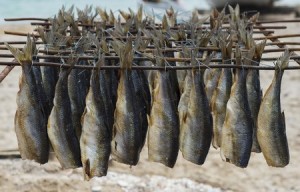 Cold smoking, a traditional method of food preservation that’s been practiced by cultures all over the globe for many centuries, does not actually cook the food. And because it doesn’t, you can leave the food in the smoke for a couple of hours and give it time to deeply penetrate, without risk either of overcooking and drying out the meat or fish or of raising an army of unfriendly food-borne bacteria. And further, since it still remains to be cooked, it makes it a perfect companion for sous vide cooking.
Cold smoking, a traditional method of food preservation that’s been practiced by cultures all over the globe for many centuries, does not actually cook the food. And because it doesn’t, you can leave the food in the smoke for a couple of hours and give it time to deeply penetrate, without risk either of overcooking and drying out the meat or fish or of raising an army of unfriendly food-borne bacteria. And further, since it still remains to be cooked, it makes it a perfect companion for sous vide cooking.
Cold smoking is usually done in the 70F to 100F (20C to 37C) range, obviously far below the final ideal cooking temperature for even the rarest of meat or fish. The antimicrobial effects of the smoke itself (and the salt or sugar cures usually applied beforehand) allow safe smoking for up to 2 or 3 hours, even though these temperatures are firmly within the ‘danger’ zone for bacterial growth. The experts recommend applying about 40 minutes of cold smoke to steaks and chops and up to 2 or 3 hours for roasts or thicker cuts. Then either refrigerating below 40F/5C or immediately cooking.
There are several types of devices you can use for cold smoking, depending on how much smoking you do and how often, from the Cadillac for the serious smoking afficianado, such as a Bradley Cold Smoker, to the entry level models, such as inexpensive pellet smokers you can use with your closed-lid grill.
Other Smoking Methods
Another alternative for quick application of smoke would be to go high tech and use the Smoking Gun, which since it just adds a surface blanket of smoke is best applied to the product after sous vide cooking and just before searing.
One last alternative, the cheapest and easiest to use, is to add a little bit of Powdered Smoke to your dry rub or seasoning mixture, applied before you put the food into the pouch for sous vide cooking. In our experience, even with long cooking of short ribs or tri-tip, the smoky aroma is still quite pronounced, though the flavor, while nice, is somewhat fainter.







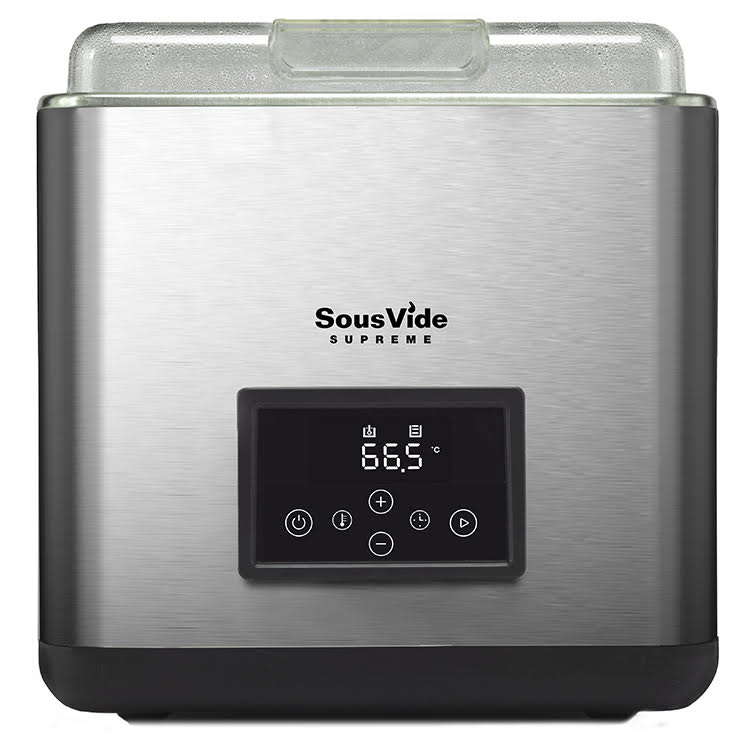
 Easy Returns & Exchanges
Easy Returns & Exchanges Shipping Rates & Info
Shipping Rates & Info Satisfaction Guarantee
Satisfaction Guarantee Contact Us
Contact Us Email your questions to
Email your questions to 

3 Responses to Smoking and Sous Vide: The Great Debate